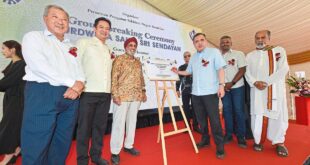ALOR SETAR: Two almost-perfect statues and an ancient inscription from the Pallava dynasty have been discovered during an archaeological excavation at the Bukit Choras Archaeological Site in Yan.
The discovery by the Universiti Sains Malaysia (USM) Centre for Global Archaeological Research (CGAR) and the National Heritage Department (NHD) took place at the summit of Bukit Choras between Aug 28 and Sept 12.
USM CGAR senior lecturer Dr Nasha Rodziadi Khaw, who led the excavation, said the find from the temple site could date back to around the 8th or 9th century AD, which is the same as most of the temple sites in the Bujang Valley, and development period of the Srivijaya Empire.
“The uniqueness of this temple at this archaeological site is firstly, how it has been preserved and the condition of the walls in the north, west and south areas.
“Secondly, we found two human-sized structures made out of stucco… and the discovery of stucco has not been reported in the Bujang Valley but only in Sumatra and Java,” he said yesterday.
The Pallava dynasty, which flourished around the 6th to 8th century AD, introduced its writing to South-East Asia, resulting in many communities using modified versions of the script such as the Kawi used by the Balinese, Bugis, Javanese and Sundanese, Lanna, Tham and Khom of Thailand, the Pyu in Burma, the Khmer in Cambodia and the Cham in Vietnam.
ALSO READ: 41 prehistoric remains to return home
The Bukit Choras Archaeological Site, which was designated a heritage site under the National Heritage Act 2005 in December 2016, has now brought to light previously hidden treasures.
Nasha said based on preliminary research, there is a similarity between the temple architecture in Bukit Choras and that of the temples in West Java and Sumatra, raising questions about the cultural relationship between Kedah Tua and other sites in South-East Asia.
‘The temple is estimated to measure nine square metres, but the actual size can only be confirmed after the excavation work is done, which is currently 40% complete.”
He said the Bukit Choras Archaeological Site is considered special due to its isolated position north of Gunung Jerai, whereas the other archaeological sites in Bujang Valley are mostly situated south of Gunung Jerai around Sungai Merbok and Sungai Muda.
“My team still needs time to do more on-site research, perhaps for several years, before any conclusion can be made about the ancient site.
“I hope we can provide more information and data that can add value to the history of Kedah Tua.
“This temple is also the biggest ever found in Bujang Valley and has an interesting architecture,” he added.
USM vice-chancellor Prof Datuk Dr Abdul Rahman Mohamed said the university would continue working with the NHD to carry out more excavation at archaeological sites to further expand archaeo-tourism products.
He said the research team has been conducting excavations at the archaeological sites in Bujang Valley for the last 10 years and has been doing it with funds from the Higher Education Ministry.
“We are working with the NHD and other relevant agencies on how to develop our archaeo-tourism and with this discovery, our history can be improved,” he said.
 BeritaKini.biz Berita Viral Terkini di Malaysia
BeritaKini.biz Berita Viral Terkini di Malaysia





